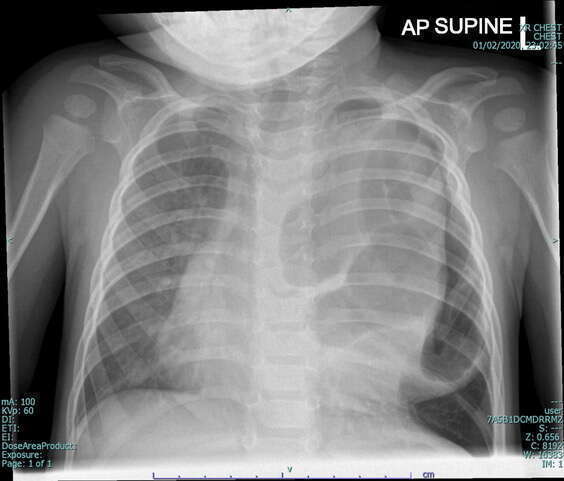
Cyst-like: An Incongruent Chest X-ray
2Respiratory Paediatrics, University Hospital of Wales, Cardiff, UK
3Paediatric Oncology, University Hospital of Wales, Cardiff, UK
Clinical Case: A 10 month old boy was admitted to the children`s ward with a cough and a fever. He had presented four days earlier and had been discharged with oral antibiotics. On examination there was fever and decreased air entry on the left side of the chest. A chest X-ray shwed an unusual multi-locular cystic lesion, possibly representing bowel loops, in the chest with lung tissure visible inferiorly. There was minimal mediastinal deviation to the right. Bowel sounds had not been heard in the chest. The rest of the examination was unremarkable. Chest CT revealed a left-sided cystic parenchymal lung lesion.
Differential Diagnosis:
Congenital diaphragmatic hernia is increasingly diagnosed antenatally. Postnatally, it can present with respiratory distress, a scaphoid abdomen, bowel sounds in the chest and abnormal CXR. Occasionally, it presents in childhood with respiratory or abdominal symptoms. Other differentials included Congenital Cystic Adenomatoid Malformation (CCAM), bronchogenic cyst, pulmonary sequestration, or necrotising staphylococcal pneumonia. Congential thoracic malformations are usually smaller with later presentation, or, if extensive, evident from birth or antenatally. Chilren with staphylococcal pneumonia would be very ill.
Pleuropulmonary Blastoma: Open lobectomy and histology revealed the rare primary neoplasm Pleuropulmonary Blastoma(PPB), type II. Pleuropulmonary blastoma is an embryonal tumour occurring in the lungs. There are three histological subtypes, which correlate with age of presentation and outcome. Type I PPBs are multipocualted, are filled cysts, which may progress to become type II PPB (cystic and solid). Type III PPB are comprised of tumour cells only.
PPB is associated with a germline loss-of-function mutationin the DICER1 gene on chromosome 14q32, and a second tumour-specific missense mutation. Individuals and families identified with this mutation should have surveillance for PPB, thyroid nodules and tumours, germ cell tumours in females, Wilms` tumours, and ophthalmology examination.

Powered by Eventact EMS